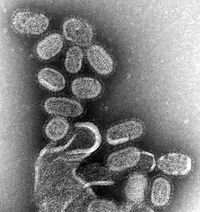
Photo from wikipedia
Respiratory influenza A virus (IAV) infection continues to pose significant challenges in healthcare of human diseases including asthma. IAV infection in mice was shown to increase IL-33, a key cytokine… Click to show full abstract
Respiratory influenza A virus (IAV) infection continues to pose significant challenges in healthcare of human diseases including asthma. IAV infection in mice was shown to increase IL-33, a key cytokine in driving airway inflammation in asthma, but how IL-33 is regulated during viral infection remains unclear. We previously found that a genetic mutation in Toll-interacting protein (Tollip) was linked to less airway epithelial Tollip expression, increased neutrophil chemokines, and lower lung function in asthma patients. As Tollip is involved in maintaining mitochondrial function, and mitochondrial stress may contribute to extracellular ATP release and IL-33 secretion, we hypothesized that Tollip downregulates IL-33 secretion via inhibiting ATP release during IAV infection. Wild-type and Tollip knockout (KO) mice were infected with IAV and treated with either an ATP converter apyrase or an IL-33 decoy receptor soluble ST2 (sST2). KO mice significantly lost more body weight and had increased extracellular ATP, IL-33 release, and neutrophilic inflammation. Apyrase treatment reduced extracellular ATP levels, IL-33 release, and neutrophilic inflammation in Tollip KO mice. Excessive lung neutrophilic inflammation in IAV-infected Tollip KO mice was reduced by sST2, which was coupled with less IL-33 release. Our data suggest that Tollip inhibits IAV infection, potentially by inhibiting extracellular ATP release and reducing IL-33 activation and lung inflammation. In addition, sST2 may serve as a potential therapeutic approach to mitigate respiratory viral infection in human subjects with Tollip deficiency.
Journal Title: Journal of innate immunity
Year Published: 2022
Link to full text (if available)
Share on Social Media: Sign Up to like & get
recommendations!